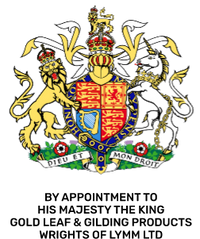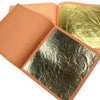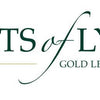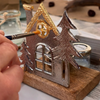Gold Leaf Across the World - Denmark
- by Sam Wozniak
Gold Leaf in Denmark: A Shimmering Story of Art, Faith, and Craftsmanship
Gold leaf — the delicate, hammered sheets of pure gold — has long been a symbol of divine beauty, prestige, and artistic mastery. In Denmark, the story of goldleaf (both 24 carat and 23.5 carat) stretches from the medieval period to the present day, where gilding continues to illuminate monumental buildings, religious treasures, and contemporary artworks.
This article explores the rich history of gold leaf in Denmark, its use in gilding monumental churches and palaces, its role in restoration projects, and its continuing presence in modern art and design.
The Origins of Gold Leaf in Denmark
The use of gold leaf in Denmark dates back to the Middle Ages, when Christianity brought with it a strong tradition of gilded art and architecture. Churches and monasteries across Denmark began adopting gilding techniques as a way of elevating sacred spaces. The light-reflecting properties of goldleaf made it ideal for symbolizing the divine, turning ordinary wooden altars or icons into radiant testaments of faith.
Danish artisans initially relied on imported techniques from Germany and the rest of Europe, where gilding had already become an established practice. Over time, local craftsmen adapted these methods to suit Danish styles, producing unique forms of gilded carvings, manuscripts, and church furnishings.
Medieval Churches and Monumental Gilding
By the High Middle Ages, monumental gilding had become a hallmark of Danish ecclesiastical art. Cathedrals such as Roskilde Cathedral (a UNESCO World Heritage Site) and Aarhus Cathedral contain examples of gilded altarpieces and sculptures that highlight the grandeur of the era.
Gold leaf was not used sparingly. Altars, pulpits, crucifixes, and even choir stalls were frequently covered in gilded decoration, usually applying 23.5 carat goldleaf. This slightly alloyed version of gold leaf was favoured for its durability, as it resisted tarnishing while maintaining a rich, luminous glow.
The visual effect of gilding inside these monumental churches was profound. In the flicker of candlelight, the surfaces shimmered, creating an otherworldly atmosphere meant to draw worshippers closer to God.
The Renaissance and Baroque Influence
During the Renaissance and Baroque periods, Denmark saw a renewed enthusiasm for gold leaf, heavily influenced by European courtly tastes. Royal palaces, civic buildings, and aristocratic homes adopted gilding to project wealth and prestige.
King Christian IV, one of Denmark’s most ambitious monarchs, commissioned numerous building projects in the 17th century. Many of these, including sections of Frederiksborg Castle, feature extensive use of gilded woodwork, ceilings, and decorative details. The castle’s chapel, in particular, showcases stunning examples of goldleaf applied to carved wood and plaster, blending sacred symbolism with royal magnificence.
While 23.5 carat gold leaf was the most commonly used, certain ceremonial objects and royal treasures employed 24 carat gold leaf, chosen for its purity and unmatched brilliance.
The Role of Gold Leaf in Decorative Arts
Beyond monumental architecture, gold leaf became central to Denmark’s decorative arts. Furniture, picture frames, mirrors, and even musical instruments were enhanced with gilding. Danish craftsmen mastered both water gilding and oil gilding techniques, depending on the surface material and desired effect.
The 18th and 19th centuries saw Denmark’s guild system and artisan workshops flourish, producing gilded items for both religious institutions and private patrons. These objects were often passed down as heirlooms, embedding gold leaf into the fabric of Danish cultural heritage.
Gold Leaf in Restoration Projects
One of the most significant uses of gold leaf in Denmark today is in restoration. Historic churches, castles, and cultural landmarks require ongoing care to preserve their gilded details. Modern restorers often use 23.5 carat goldleaf, striking a balance between purity and durability.
For example, conservation work at Roskilde Cathedral has included the careful application of new gold leaf to altarpieces and decorative carvings. Similarly, restoration projects at Frederiksborg Castle and Christiansborg Palace involve the use of traditional gilding methods to maintain authenticity.
Restoration with gold leaf is a meticulous process. Surfaces must be cleaned, repaired, and prepared with special adhesives before wafer-thin sheets of gold are applied. Whether it is 23.5 carat or 24 carat gold leaf, restorers ensure the materials match the original, preserving both the artistic and historical integrity of these monumental works.
Gold Leaf in Modern Danish Art and Design
While gilding may conjure images of medieval churches or Baroque palaces, gold leaf remains a vital material in contemporary Danish culture. Artists and designers are reinterpreting goldleaf in fresh and innovative ways, bridging the past with the present.
Contemporary Danish artists use 24 carat gold leaf to create striking contrasts in paintings and sculptures. Gold’s symbolic resonance — wealth, eternity, divinity — makes it a powerful medium for modern expression. In architecture and interior design, gilded surfaces add elegance and luxury, whether applied to modern furniture, decorative panels, or bespoke installations.
Even in fashion and product design, goldleaf finds its place. Danish brands have experimented with gilded accents on everything from jewellery to limited-edition lifestyle goods, reflecting both tradition and modernity.
Edible Gold Leaf: A Modern Luxury in Denmark
An unexpected but increasingly popular use of 24 carat gold leaf is in gastronomy. Edible goldleaf is sometimes used by high-end restaurants and bakeries in Denmark to garnish desserts, chocolates, and cocktails. While it has no flavour, its visual impact conveys luxury and exclusivity.
Though less common than in countries like the UAE or Japan, the trend of edible goldleaf in Denmark demonstrates its versatility and enduring association with prestige.
Why 23.5 Carat and 24 Carat Matter
The choice between 23.5 carat and 24 carat gold leaf may seem subtle, but it is important in both historical and modern applications.
-
23.5 carat goldleaf is slightly alloyed, making it more durable. This makes it ideal for outdoor gilding, restoration of architectural details, and objects that require longevity.
-
24 carat gold leaf is pure gold. It offers unmatched brilliance but is softer and more delicate, making it perfect for indoor applications, fine artwork, or edible uses.
Understanding this distinction helps explain why both types of gold leaf are still widely used across Denmark, depending on the context.
The Monumental Legacy of Gold Leaf in Denmark
From medieval altarpieces to contemporary art installations, the legacy of gold leaf in Denmark is both monumental and enduring. It has served as a bridge between the sacred and the secular, the traditional and the modern.
In churches, castles, and museums, gilded details continue to inspire awe. In restoration workshops, artisans carefully reapply 23.5 carat goldleaf to preserve the brilliance of the past. And in modern design studios, 24 carat gold leaf is being reimagined for a new generation.
Goldleaf in Denmark is more than a decorative material — it is a cultural symbol of light, prestige, and continuity. Its history reflects Denmark’s evolution, while its present use shows that this ancient craft still has a place in today’s creative landscape.
Conclusion
The story of gold leaf in Denmark is one of resilience, artistry, and transformation. Whether in monumental churches, royal palaces, delicate restoration projects, or contemporary design, gilding continues to shine as part of Denmark’s cultural identity.
By embracing both 23.5 carat goldleaf for its durability and 24 carat gold leaf for its unmatched purity, Denmark maintains a living connection to its gilded past while creating new expressions for the future.
For visitors and art lovers alike, Denmark’s goldleaf heritage offers a shimmering journey through history — one that continues to dazzle, inspire, and evolve.






